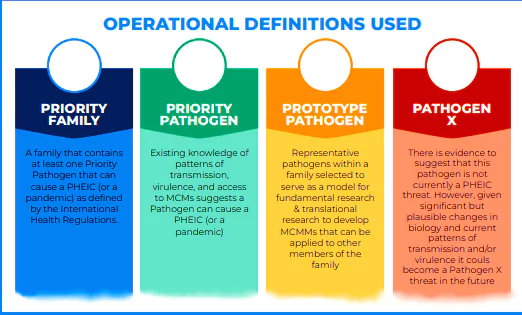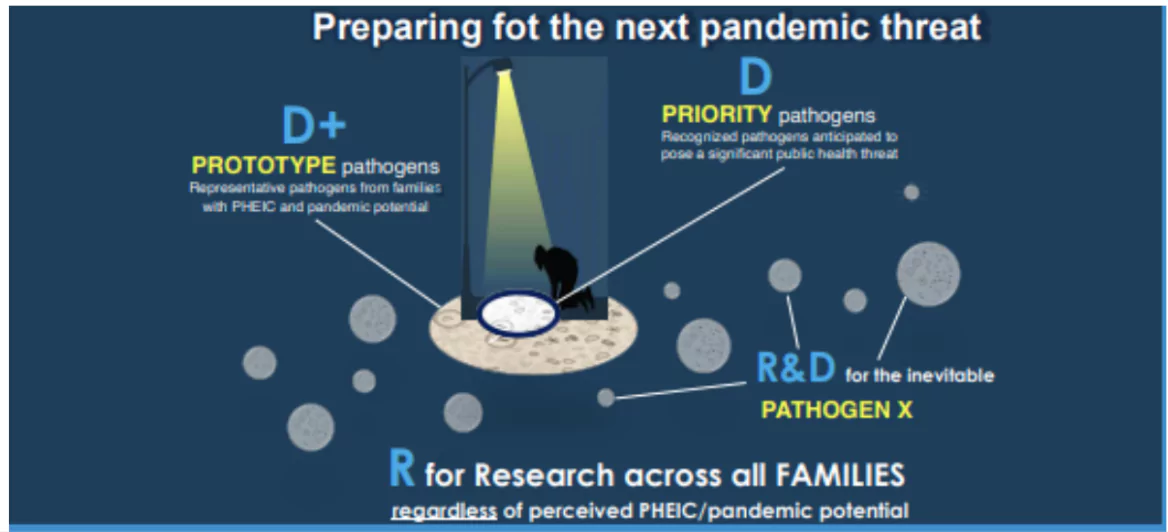The World Health Organisation (WHO) has recently released its ‘Pathogens Prioritization’ Report.
- The report is a framework for epidemic and pandemic research preparedness
 Sample Size: The Research involved over 200 scientists from 54 countries, evaluating the evidence related to 28 viral families and one core group of bacteria, encompassing 1,652 pathogens.
Sample Size: The Research involved over 200 scientists from 54 countries, evaluating the evidence related to 28 viral families and one core group of bacteria, encompassing 1,652 pathogens. -
- The Final List: It comprises over 30 ‘priority pathogens’
Key Highlights of the Report
- Priority Pathogen: It is a list of pathogens (virus and bacterial) prepared by WHO at the global level , assessing the entire Pathogen Families containing pathogens that can infect humans and have the potential to cause outbreaks or pandemics or for its risk of causing a Public Health Emergency of International Concern or PHEIC.
- Bacterial Pathogens Priority List (BPPL): The WHO had also updated its Bacterial Pathogens Priority List (BPPL) including gram-negative bacteria resistant to last resort antibiotics, and Mycobacterium tuberculosis resistant to the antibiotic Rifampicin.
- The list had featured 15 families of antibiotic-resistant bacteria.
- Prepared by: The WHO R&D Blueprint for Epidemics
- The body functions as a global platform for research and development collaboration, to expedite the research and development of medical countermeasures (MCMs) to respond to epidemics and pandemics
- Approach: The Report is a scientific framework to enhance preparedness for forthcoming outbreaks, Public Health Emergencies of International Concern (PHEICs), and pandemics by focusing on research of Viral and Bacterial Families.\
Enroll now for UPSC Online Course
- Need: The Report will act as a pointer for the governments to allocate resources towards surveillance and medical countermeasures for these pathogens.
- Surveillance Aspect:
- The Spread of a pathogen beyond a geographical area
- The Virulent behaviour of the pathogen
- Changes in its transmissibility rate
- Changes in the clinical manifestation of the disease it causes
- The Resistance rate to the known treatment and does it have vaccine escape properties
- Strategy: The 2024 report, for the first time, has incorporated the concept of the ‘Family approach’ and the ‘Prototype Pathogen’. Some of the “new” Priority Pathogens’ included this year were noted in 2017 and or 2018 as pathogens of concern
- The Family Approach: The research has been prioritised for the entire pathogen Families as opposed to a handful of individual pathogens to bolster the response capability to unforeseen variants, emerging pathogens, zoonotic transmissions, and unknown threats such as ‘Pathogen X.
- Pathogens within a family have a lot of similarities and also share genetic material, meaning an existing treatment option or vaccine for one strain of the family could potentially be repurposed for another.
- The Prototype Pathogens: They are the representative pathogens within a family which are selected to serve as a model for fundamental research to develop medical countermeasures that can be applied to other members of the family.
- Regional Priority Pathogens:
- African Region:
- Main Priorities: The Filoviruses (Orthoebolavirus zairense, sudanense, and marburgense), Orthopoxvirus monkeypox, and Mammarenavirus lassaense.
- Others: It includes all the three priority Orthoflaviviruses (denguei, encephalitidis, and zikaense), and Alphavirus chikungunya.
- Prototype Pathogens:Mammarenavirus lujoense and the Phlebovirus riftense.
- American Region:
- The Priority Pathogens: Orthohantavirus sinnombrense, and Alphavirus venezuelan are specific to the region.
- Endemic: All three priority Orthoflaviviruses (denguei, encephalitidis, and zikaense) are endemic in the Region.
- The Prototype Viruses: Mammarenavirus juninense and Orthobunyavirus oropoucheense
- Eastern Mediterranean Region:
- Priority Pathogens: Subgenus merbecoviruses and enterovirus coxsackiepol.
- Bacterial pathogens: It includes Vibrio cholera O139 and Shigella dysenteriae serotype 1.
- European Region:
- Priority Pathogen: Orthonairovirus haemorrhagiae occurs in the European Region with the prototypes Orthoflavivirus encephalitidis and Orthobornavirus bornaense mostly found in this region.
- South East Asia Region:
- Bacterial Priority Pathogens: It includes Vibrio cholera O139 and Shigella dysenteriae serotype 1.
- Endemic Priority Pathogens: Henipavirus nipahense and Bandavirus dabieense, and the mosquito-borne Orthoflavivirus denguei and zikaense, Alphavirus chikungunya are endemic in the South-East Asia Region
- Prototype Pathogen: Orthohepadnavirus hominoidei genotype C is most common in the South-East Asia Region.
- Western Pacific Region:
- Priority Pathogen: Influenza and Subgenus sarbecoviruses are a high priority in the Western Pacific region.
- Endemic: The priority pathogens are henipavirus nipahense, Orthohantavirus hantanense and Bandavirus dabieense,
- Mosquito -borne Orthoflavivirus denguei and Alphavirus chikungunya.

Check Out UPSC CSE Books From PW Store
![]() 9 Aug 2024
9 Aug 2024
 Sample Size: The Research involved over 200 scientists from 54 countries, evaluating the evidence related to 28 viral families and one core group of bacteria, encompassing 1,652 pathogens.
Sample Size: The Research involved over 200 scientists from 54 countries, evaluating the evidence related to 28 viral families and one core group of bacteria, encompassing 1,652 pathogens. 
